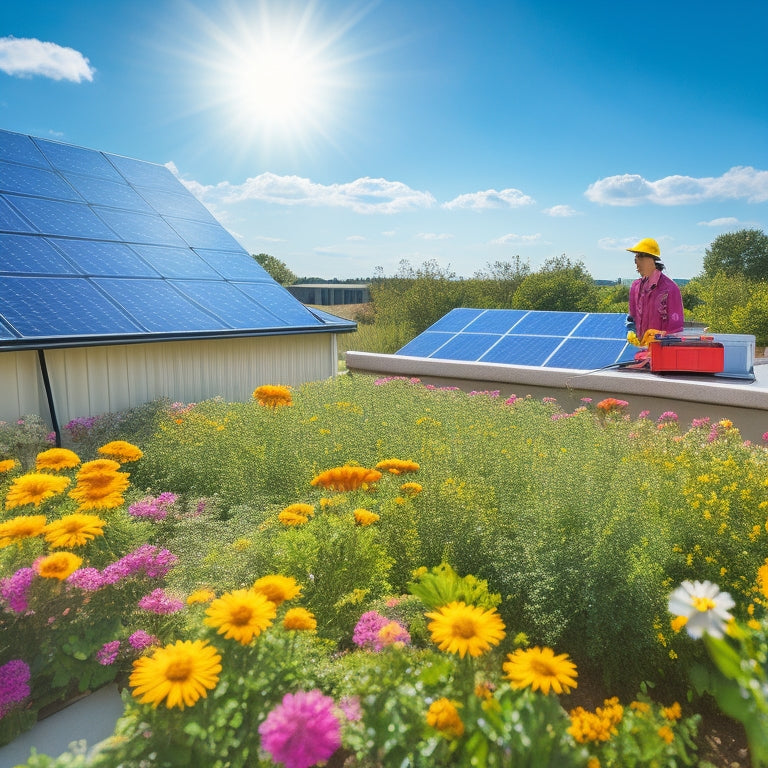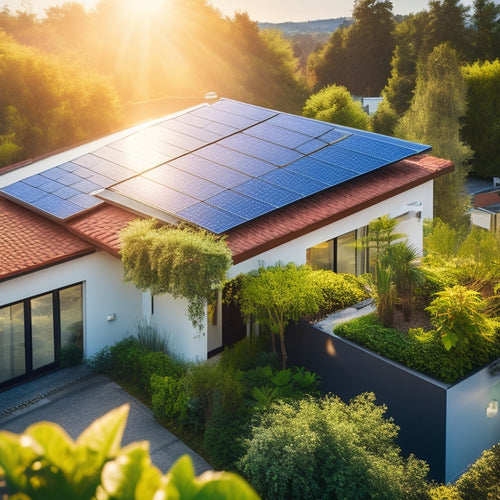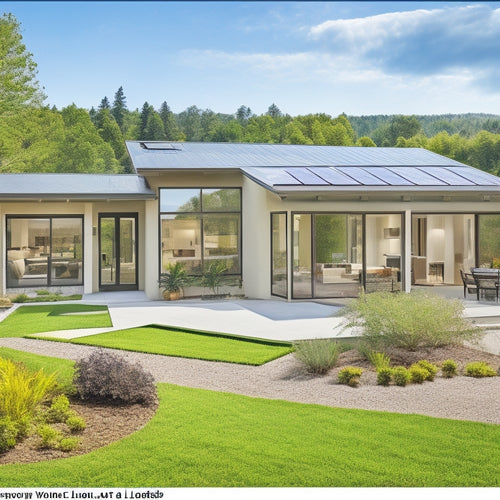
What to Expect From a Residential Solar Power Installation?
Share
When you opt for a residential solar power installation, you'll need to evaluate the costs, incentives, and financing options available. Your home's suitability will be assessed, including roof size, orientation, and shading impact. You'll select the right equipment, including panel types, brands, and warranties, and understand how panel efficiency and inverter technology affect energy production. The installation process will take several days to weeks, and necessary permits and inspections will guarantee compliance with local regulations. Once installed, you'll enjoy energy savings, a potential increase in property value, and ongoing support - and that's just the beginning of your solar expedition.
Key Takeaways
- Residential solar power installation involves assessing home suitability, choosing the right equipment, and considering panel efficiency and inverter technology options.
- The installation process typically takes several days to weeks, including site assessment, roof preparation, installation, and inspection.
- Ongoing monitoring and maintenance are necessary to ensure peak performance and longevity, with options for extended warranties or maintenance packages.
- Solar power installation can lead to significant energy savings and ROI, including reduced electricity bills, increased property value, and environmental benefits.
- Homeowners can expect ongoing support and warranty coverage, typically spanning 10-25 years, with dedicated customer support and regular system monitoring.
Understanding Solar Panel Costs
Your wallet takes a significant hit when investing in residential solar power, with solar panel costs being a major contributor to the overall expense. The type of installation you choose affects the cost, with grid-connected systems being more affordable than off-grid systems that require battery storage.
You can investigate financing options, such as solar loans, to make the upfront cost more manageable. In addition to the initial investment, you'll need to evaluate maintenance costs, which are typically low.
However, the long-term benefits far outweigh the costs. You'll enjoy energy independence, reducing your reliance on the grid and saving on your utility bills.
Additionally, you'll contribute to environmental benefits, reducing your carbon footprint and supporting a sustainable future. The federal government also offers incentives, such as tax credits, to encourage homeowners to invest in solar power.
Assessing Your Home's Suitability
You'll need to evaluate your home's roof size and shape to determine if it can accommodate a solar panel system that meets your energy needs.
Additionally, you'll need to assess the extent of shading and obstructions on your roof, such as skylights, vents, or trees, which can impact the system's overall performance.
Roof Size and Shape
The roof's dimensions and geometry play an essential role in determining the viability of a residential solar power installation. You'll want to evaluate the size and shape of your roof to guarantee it can accommodate the necessary solar panels. A larger roof provides more space for panels, but even smaller roofs can still support a viable installation.
Your roof's orientation is critical, as a south-facing roof receives the most direct sunlight. An east- or west-facing roof can still work, but a north-facing roof may not be suitable.
The installation angle of your solar panels is also important. A steeper angle can help with snow removal, but may not be ideal for energy production.
The shape of your roof can impact the installation process. A simple, rectangular roof is typically easier to work with than a complex, multi-angled roof.
Shading and Obstructions
Now that roof size and shape have been evaluated, it's time to examine the impact of shading and obstructions on your home's suitability for a residential solar power installation.
Shading analysis is vital in determining how much energy your solar panels will produce. Even partial shading can greatly reduce energy output, so it's important to identify areas where trees, buildings, or other obstructions cast shadows on your roof.
Obstruction types can be categorized into two groups: permanent and temporary. Permanent obstructions include chimneys, vents, and skylights, while temporary obstructions might be trees that can be trimmed or removed.
Your solar installer will conduct a thorough shading analysis to identify these obstructions and determine their impact on your system's performance. This analysis will help you decide whether to prune trees, remove obstructions, or adjust the solar panel layout to minimize shading effects.
Choosing the Right Equipment
When choosing the right equipment for your residential solar power installation, you'll need to select solar panels that meet your energy needs and budget.
The efficiency of these panels will play a significant role in determining how much power your system can generate.
You'll also need to evaluate inverter technology options, as they convert DC power from the panels into usable AC power for your home.
Solar Panel Selection
Selecting the right solar panels for your residential solar power installation is a critical decision, as it directly impacts the system's overall performance and efficiency.
You'll need to take into account various factors, including panel types, brand comparisons, and warranty options.
When evaluating panel types, you'll encounter monocrystalline, polycrystalline, and thin-film options. Monocrystalline panels are the most efficient but also the most expensive. Polycrystalline panels offer a balance between efficiency and cost, while thin-film panels are the most budget-friendly but less efficient.
-
Research and compare top brands like Tesla, SunPower, and Panasonic to find the best fit for your budget and energy needs.
-
Look for panels with high durability ratings and weather-resistant coatings to guarantee they can withstand your local climate.
-
Be sure to check the warranty offered by each brand, as it can vary greatly and impact your long-term costs.
Panel Efficiency Matters
You've narrowed down your solar panel options, but it's crucial to investigate further into the equipment itself to ascertain you're getting the most out of your residential solar power installation. Panel efficiency matters, as it directly affects the amount of energy your system produces. With advancements in solar technology, panel efficiency has improved markedly over the years.
| Panel Efficiency | Description |
|---|---|
| Low Efficiency (15-17%) | Lower cost, but more panels required to meet energy needs |
| Mid-Range Efficiency (18-20%) | Balanced cost and energy production, suitable for most homes |
| High Efficiency (21-23%) | Higher cost, but fewer panels required, ideal for smaller roofs |
| Premium Efficiency (24%+) | Highest energy production, typically used for commercial installations |
When selecting solar panels, consider the trade-off between panel efficiency and cost. Higher efficiency panels may be more expensive, but they can provide more energy per unit area. Additionally, consider the panel lifespan, as higher efficiency panels tend to last longer. By choosing the right equipment, you can maximize your energy production and guarantee a successful residential solar power installation.
Inverter Technology Options
The heart of your residential solar power installation's energy conversion process lies in the inverter technology. This critical component converts the DC power generated by your solar panels into AC power, which is usable in your home.
When choosing an inverter, you'll encounter two primary options: string inverters and micro inverters.
-
String Inverters: These traditional inverters connect multiple solar panels in a series, forming a "string." They're often more affordable upfront but can be less efficient if one panel is shaded or underperforming, affecting the entire string.
-
Micro Inverters: These inverters are installed beneath each individual solar panel, allowing each panel to operate independently. They provide more flexibility, monitoring, and troubleshooting capabilities, but come at a higher upfront cost.
-
Hybrid Inverters: A newer option, hybrid inverters combine the benefits of string and micro inverters, offering a balance between cost and performance. They allow for panel-level monitoring and optimization while still being more affordable than micro inverters.
Understanding the differences between these inverter technologies will help you make an informed decision for your residential solar power installation.
Installation Process and Timeline
Your solar panel system's installation process typically begins with a site assessment, where a technician evaluates your property's energy usage and solar potential. During this assessment, the technician will identify the most suitable locations for your solar panels, considering factors such as roof size, orientation, and shading.
After the site assessment, the installation team will prepare your roof for the solar panel installation, which includes removing existing roofing materials, installing mounting hardware, and ensuring the roof is structurally sound.
The installation of the solar panels themselves typically takes a few days, depending on the size of your system.
The installation timeline can vary depending on the complexity of the project, but most residential installations can be completed within a few weeks. Key project milestones include the installation of the mounting system, installation of the solar panels, and connection of the system to your electrical panel.
Throughout the installation process, you'll receive updates on the progress and be informed of any changes to the installation timeline.
Necessary Permits and Inspections
Before commencing the solar panel installation, it's essential to obtain necessary permits and pass inspections to confirm compliance with local building codes and regulations.
You'll need to make sure that your installation meets the requirements of your local government, including zoning regulations and electrical codes. Failing to do so can result in fines, penalties, or even removal of the system.
Some of the necessary permits and inspections include:
-
Building permit: This permit guarantees that your solar panel installation meets local building codes and regulations.
-
Electrical permit: This permit ensures that the electrical connections and wiring meet the electrical codes and standards.
-
Final inspection: A thorough inspection is conducted to verify that the installation meets all the necessary standards and regulations, and that it's safe for operation.
System Monitoring and Maintenance
Solar panels require ongoing monitoring and maintenance to guarantee peak performance and longevity. You'll want to keep a close eye on your system's energy production to verify it's running at its best. This is where system monitoring comes in.
With remote access, you can track your energy production in real-time, receiving system alerts if any issues arise. This allows you to identify and address problems quickly, minimizing downtime and maximizing energy output.
Regular maintenance is also essential to prevent damage and extend the lifespan of your solar panels. Your installer will typically provide routine maintenance checks, which may include cleaning the panels, inspecting electrical connections, and verifying system performance.
Additionally, some installers offer extended warranties or maintenance packages that cover repairs and replacements.
Energy Savings and ROI
By investing in a residential solar power installation, you're prepared to reap considerable energy savings and a substantial return on investment (ROI).
As a homeowner, you can expect to reduce your reliance on the grid and lower your electricity bills. In fact, solar panels can save you hundreds or even thousands of dollars per year on energy costs.
-
You'll enjoy long-term savings, as the cost of solar energy is considerably lower than traditional fossil fuels.
-
Solar panels increase your property value, making your home more attractive to potential buyers if you decide to sell in the future.
-
The financial benefits of solar energy are further amplified by the fact that solar panels require minimal maintenance and can last for up to 30 years or more.
With a residential solar power installation, you can expect to see a considerable ROI over the lifespan of your system.
In addition to the financial benefits, you'll also be reducing your carbon footprint and contributing to a cleaner, more sustainable environment.
Incentives and Rebate Options
Government incentives and rebate options can greatly offset the upfront cost of your residential solar power installation. As you consider investing in solar power, you'll want to investigate the various incentives available to you.
| Incentive Type | Description | Benefits |
|---|---|---|
| Federal Incentives | 26% tax credit on total system cost | Reduces taxable income by 26% of system cost |
| State Rebates | Varies by state, but typically $0.50 to $1.00 per watt | Direct rebate on system cost |
| Local Programs | Varies by locality, but may include property tax exemptions or low-interest loans | Reduces system cost or financing burden |
| Utility Incentives | Varies by utility company, but may include net metering or feed-in tariffs | Reduces electricity bills or generates revenue |
| Financing Options | Low-interest loans, power purchase agreements, or leases | Spreads system cost over time or reduces upfront cost |
These incentives can greatly reduce the cost of your solar power installation, making it more accessible and affordable. Additionally, you may be eligible for grant opportunities or other energy efficiency programs that can further offset the cost. Be sure to research the specific incentives available in your area to maximize your savings.
Ongoing Support and Warranty
Now that you've examined the incentives and rebate options available for your residential solar power installation, it's time to reflect on the long-term benefits that come with your investment.
A significant aspect of your solar power system is the ongoing support and warranty that comes with it. This is where your installer's commitment to quality and customer satisfaction really matters.
When it comes to warranty coverage, you can expect:
- A thorough warranty that covers parts and labor for a significant period, usually 10-25 years
- Dedicated customer support to address any concerns or issues that may arise
- Regular system monitoring to guarantee peak performance and energy production
With ongoing maintenance, you can rest assured that your system will continue to perform at its best. This includes routine inspections, cleaning, and repairs to prevent any potential issues.
Frequently Asked Questions
Can I Install Solar Panels on a Rented Property?
You'll need to obtain your landlord's permission before installing solar panels on a rented property, typically through a solar panel agreement that outlines terms, responsibilities, and benefits for both you and your landlord.
Will My Solar Panels Be Covered by Homeowner's Insurance?
You'll likely find that your homeowner's insurance policy covers your solar panels, but you'll want to verify insurance coverage during the installation process, as some policies may require a separate endorsement or rider to guarantee you're fully protected.
Can I Sell Excess Energy Back to the Grid?
Like a modern-day Robin Hood, you'll be giving back to the grid, not taking from it. Through net metering benefits and energy credit systems, you'll be selling excess energy and earning credits, reducing your utility bills and increasing your power.
Do Solar Panels Work During Power Outages?
You'll find that solar panels don't provide power during outages in grid-tied systems, as they're designed to shut down for safety reasons. However, you can consider battery backup systems to maintain solar panel efficiency and power supply during outages.
Are There Any Solar Panel Recycling Options Available?
You'll be surprised to know that 95% of a solar panel's materials can be recycled; as your solar panel lifespan comes to an end, you can participate in recycling programs, ensuring a sustainable energy future.
Conclusion
As you flip the switch on your new residential solar power installation, imagine utilizing the sun's energy to power your daily life. Watch your utility bills shrink, your carbon footprint dwindle, and your property value soar. With your system up and running, you'll be generating clean energy, reaping financial rewards, and basking in the satisfaction of going green. The future is bright, and it's powered by you.
Related Posts
-

Solar Power Systems for Cost-Effective Sustainability
Investing in solar power systems is a smart move for cost-effective sustainability. You can save about $1,500 annuall...
-

How to Reduce Home Energy Bills
To reduce your home energy bills, start by investing in energy-efficient appliances and upgrading your insulation. Lo...
-

Passive Solar Design Strategies for Homes
To effectively implement passive solar design strategies in your home, focus on ideal building orientation and strate...


